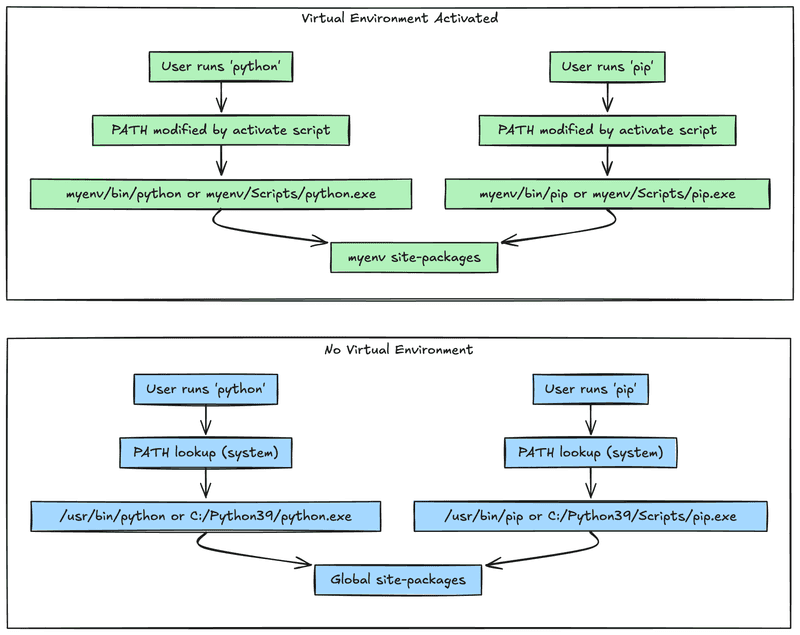How Does the Python Virtual Environment Work?
When you start working with Python, one of the first recommendations you’ll hear is to use a “virtual environment.” But what exactly is a Python virtual environment, and how does it work under the hood?
The Problem: Dependency Hell
Python projects often rely on third-party libraries. If you install packages globally, different projects can end up fighting over package versions. This is called “dependency hell.” For example, Project A might require requests==2.25, while Project B needs requests==2.31. Installing both globally can cause conflicts and break your projects.
The Solution: Virtual Environments
A virtual environment is an isolated workspace for your Python project. It lets you install packages locally, so each project can have its own dependencies, regardless of what’s installed elsewhere on your system.
How Does It Work?
When you create a virtual environment (using python -m venv myenv or virtualenv myenv), Python does the following:
-
Creates a Dedicated Directory Structure
- A bin/ or Scripts/ directory with a Python executable and activation scripts
- A lib/ directory with a copy of the Python standard library
- A pyvenv.cfg config file for metadata
myenv/ ├── bin/ # (Note: Scripts\ on Windows) │ ├── activate # Shell script to activate the environment (Unix) │ ├── activate.bat # Batch script (Windows CMD) │ ├── Activate.ps1 # PowerShell script (Windows PowerShell) │ ├── pip # Environment-specific pip │ └── python # Environment-specific Python interpreter ├── lib/ │ └── pythonX.Y/ │ └── site-packages/ # Installed packages go here ├── pyvenv.cfg # Configuration file with environment metadata -
Configures a Standalone Python Interpreter:
The environment includes its own Python executable (or a symlink to it), ensuring that all commands run from within the environment use the correct interpreter. - On most systems, this is a symlink or copy of the base Python binary - This interpreter respects only the packages installed within the environment
which python
/path/to/myenv/bin/python-
Sets Up Local Package Management:
Each environment gets its own site-packages directory:
- When you run pip install, packages go here instead of the global location
- This isolation prevents version conflicts and makes dependency management predictable
-
Creates Activation Scripts:
Activation scripts help you enter the environment by:
- Modifying your
$PATHso that python and pip point to the virtual environment - Optionally updating your shell prompt (e.g., showing (myenv))
- Ensuring commands are scoped to the environment
These scripts are OS-specific:
- Unix/macOS:
source myenv/bin/activate - Windows CMD:
myenv\Scripts\activate.bat - PowerShell:
myenv\Scripts\Activate.ps1
- Modifying your
-
Includes a Configuration File:
The
pyvenv.cfgfile records metadata about the environment, including the Python version and the location of the base interpreter.This file stores:
- The Python version used
- The path to the base interpreter
- Whether system site packages are accessible (default: no)
This metadata is used when running the environment to preserve consistent behavior.
Command Resolution
So what happens when you are in a venv as opposed to running python command globally? The diagram below illustrates how Python and pip commands are resolved with and without a virtual environment. When no virtual environment is active, your system’s PATH directs these commands to the globally installed Python interpreter and packages.
However, once a virtual environment is activated, the PATH is modified to point to the environment’s own executables. This ensures that all Python commands and package installations stay isolated within the virtual environment, avoiding conflicts with system-wide installations.

Why Is This Powerful?
- Isolation: Each project gets its own dependencies and versions.
- Reproducibility: You can lock dependencies with a
requirements.txtorpyproject.tomlfile, making it easy for others (or yourself in the future) to recreate the environment. - No Admin Rights Needed: You don’t need system-wide permissions to install packages.
Advanced Use Cases
- Multiple Python Versions: Use virtual environments to test your code against different Python versions.
- Custom Activation Scripts: Modify the activation script to set environment variables specific to your project.
- Integration with CI/CD: Virtual environments are essential for setting up isolated builds in CI/CD pipelines.
Under the Hood: What’s Really Happening?
- The virtual environment is just a directory with a specific structure.
- No containers or VMs are involved-just clever manipulation of paths and environment variables.
- Deleting the virtual environment directory removes all installed packages for that project.
Debugging Tips
- If activation doesn’t work, check your shell configuration.
- Use
python -m siteto inspect the site-packages directory. - Verify the
pyvenv.cfgfile for any misconfigurations.
Conclusion
Python virtual environments are a foundational tool for modern Python development. They solve the problem of dependency conflicts, make projects more portable, and keep your system clean. Whether you’re building a quick script or a large application, understanding how virtual environments work will save you countless headaches down the road.